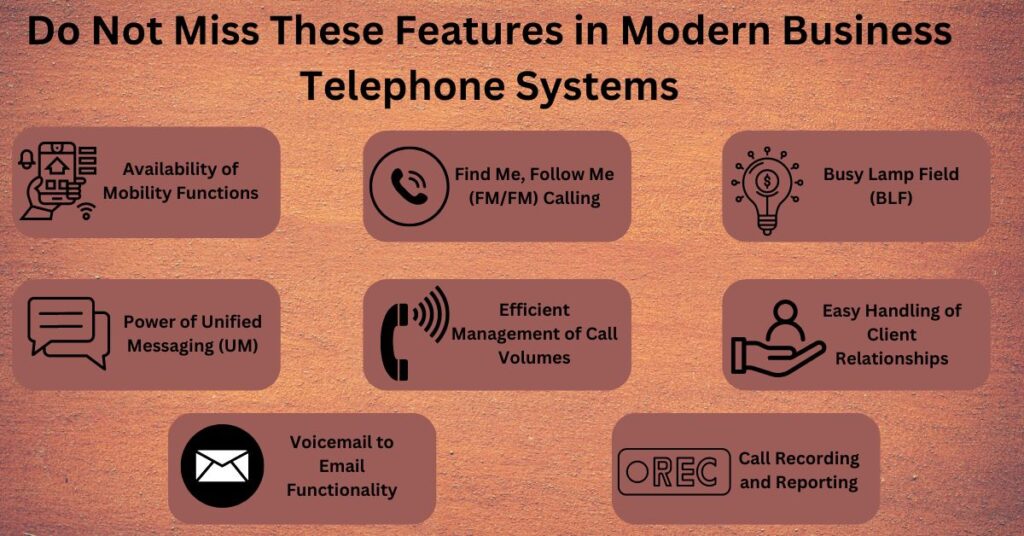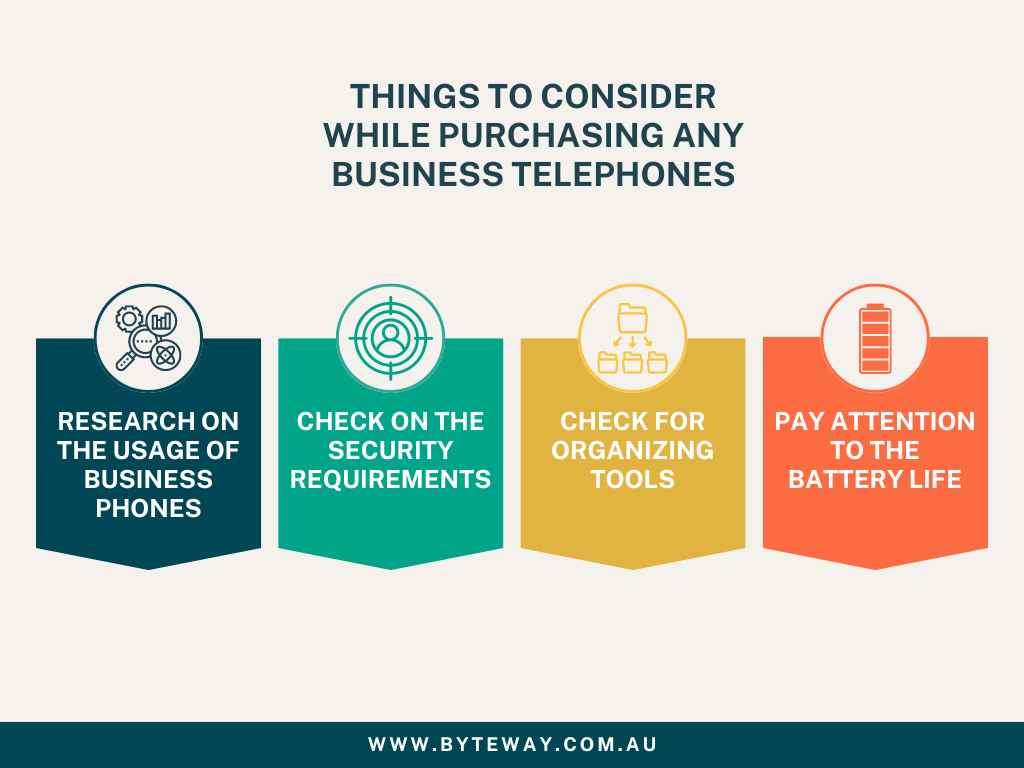No matter what type of business you run, business telephone systems are vital for effective communication. The technology can quickly determine how smoothly your business runs.
Moreover, with the onslaught of new technology, modern business phones benefit multiple businesses.
However, choosing a business phone with the right features is all you need. So, let’s get started to know about what are the Top Features of Modern Business Telephone Systems.
Top 8 Features of Modern Business Telephone Systems

Take a look at must-have features in your modern business telephone systems right away:
1. Availability of Mobility Functions
Whether it’s due to millennials in the workforce or the increased need for employee flexibility, there’s no denying the upward trend of an increasingly mobile workforce. This can include personnel who commute between offices or telework and those who travel frequently for business and are based in the field.
Mobile-friendly business phone equipment that easily integrates between desktop and mobile phones can automatically transfer calls in progress and let employees work from anywhere, allowing them to do their duties in the same way they would at the office.
Connecting your business telephone systems network to these remote workers’ cell phones and home lines or transferring calls to their designated phones allows you to remain competitive.
Customers dial the business line, and the call is routed to the appropriate contact, regardless of where they are or what device they are using. Even if the employee leaves the company, the phone line remains operational, and an employee’s number is kept hidden.
2. Find Me, Follow Me (FM/FM) Calling
Let’s face it: most firms must pay attention to calls. Missed calls can mean missed business opportunities. With Find Me, Follow Me, your phone system can free you from being tethered to your workstation during a phone call.
Think of Find Me, Follow Me as a sophisticated call routing capability that allows you to program calls to any device based on location and availability.
Business telephone systems with FM/FM can ring all your devices simultaneously or follow a specific sequence you program. You can specify a list of numbers for the system to call you at, and it will try each number until the call is answered or the list is exhausted.
For example, a call can go to your office line; if you don’t answer, it will try your cell phone; if there is still no connection, the call will be routed to a coworker; and if there is still no answer, it will be routed to voicemail.
3. Busy Lamp Field (BLF)
Busy Lamp Field (BLF) is a useful feature with numerous advantages, especially for large commercial phone systems. Integrating BLF into your business telephone systems gives you visibility into your organisation’s status in real-time.
With a quick glance, you can know who is on a call, enabling more effective call management and communication workflows. The benefits of BLF go beyond only status indications.
BLF keys offer handy one-touch capabilities for calling different extensions and transferring calls efficiently. This streamlined approach eliminates manual dialing or traversing complex menus, saving your staff time and enhancing productivity.
Consider the convenience of transferring a call to the relevant person with a simple push of a button, without the need to look for their extension or rely on out-of-date directories. BLF enables your team to handle calls quickly and correctly, ensuring clients and customers receive timely support.
4. Power of Unified Messaging (UM)
Historically, IT managers had to manage voicemail, telephones, email networks, and data separately. Users can now access their voicemail, email, fax, and text messages in a single interface, generally using a computer program included with the phone system. Having a single mailbox lets you keep all your messages in one place, eliminating the need to check numerous devices each time.
UM also improves productivity, cooperation, and customer service through your phone system. Some advanced systems even modify the format of messages to suit the device receiving them.
For example, UM can compress a voicemail to MP3 and email it to a worker outside the cell range. Some more advanced business telephone systems even allows voicemails to be transcribed and emailed as text files. UM’s versatility allows you to easily and quickly browse, delete, search, or sort your messages from any location.
4. Efficient Management of Call Volumes
Efficiently managing high call volumes is critical for firms looking to provide excellent customer service while increasing productivity. This is where call queuing comes in. With the call queuing tool, you can handle a high volume of incoming calls without worrying about them remaining ignored or being routed to voicemail during work hours.
When a caller contacts your organisation, the business telephone systems places them in a virtual queue and greets them professionally. They are then notified that their call has been queued and that their requirements will be addressed shortly.
Callers can listen to Music-On-Hold while waiting, making the waiting experience more enjoyable. They are given occasional updates on their status in the queue to keep customers informed and manage their expectations.
But call queuing is more than just keeping callers interested. The business telephone systems also give real-time and historical queue analytics, allowing you to make more educated decisions based on call traffic trends. Analysing these facts will enable you to optimise the workforce, detect peak call times, and ensure effective call handling.
5. Easy Handling of Client Relationships
A Customer Relationship Management (CRM) tool, by definition, allows you to manage your existing and prospective client relationships.
With a clever CRM, the next time you call a contact, you can see the broad picture, know precisely what to say, and be aware of what your colleagues have already said.
Business telephone systems with CRM integration provide a 360-degree picture of real-time information about your contact while allowing easy dialling and call reporting.
You can see who a contact spoke with the last time your organisation contacted them and log conversations and notes with relevant information for future calls. CRM integration determines how users place outgoing calls and manage their phone experiences.
6. Voicemail to Email Functionality
Voicemail-to-mail capabilities are helpful features that simplify and make it easier to manage voicemail messages. As a business owner wanting to upgrade their phone systems, you should grasp the advantages of this function and how it can improve your communication skills.
The business phone equipment voicemail-to-email capability effortlessly connects voicemail and email. When a new voicemail message comes into your mailbox, the system instantly sends you an email notification with all of the message’s details. In addition, the voice message is attached as an a.WAV file so that you can listen to it immediately from your email program.
The benefits of voicemail to email cannot be emphasised. It enables you to review your voicemail messages from anywhere and at any time as long as you can access your email. Whether at the office, on the go, or working remotely, you can easily access your voicemail messages with a few clicks.
7. Call Recording and Reporting
Call recordings can be used to train new personnel on past data. Recordings also provide management insight into how staff handle their conversations, allowing them to review employee interactions and address any modifications or improvements.
The function is simple to use and may be configured to record email or text recordings as needed automatically.
A call reporting feature in business telephone systems provides an administrator with concrete business indicators that can be used to make direct operational decisions. Users can view additional information, such as average talk times or get reports on single extensions and statistics for large call groups.
Together, these features are critical for ensuring quality and enhanced services for your clients, directly influencing sales, training, and management.
Things to Consider While Purchasing any Business Telephones

Check out the things you must take advantage of while purchasing business phone equipment. Take a look below:
1. Research on the Usage of Business Phones
Before purchasing business telephone systems, you should understand how your company uses mobile communication. Ask yourself and your staff how they use their phones to determine your required features and plans.
Consider your company’s communication needs to determine how you engage with clients, other businesses, and staff. Before making a decision, you can better understand what your company requires.
2. Check on the Security Requirements
Sensitive or protected data, private phone calls, and financial or personal information must be kept safe. Mobile phones pose a concern because of risks such as WiFi connectivity, hacking, and theft.
Some phones are more accessible to protect than others by using strong passwords, encrypting apps, and remote deleting if stolen or lost. Be aware of potential threats and how the mobile device you choose can keep your data secure. Then, study which business telephone systems are best for security.
3. Check for Organizing Tools
Calendars, reminders, password keepers, and other features are available on all types of smartphones. Organising the workday and keeping track of your personnel is critical.
Choose a business telephone systems that makes it simple to do so. The ability to link your phone calendar with your work agenda or search for your password helps to streamline your day. Determine which tools are the easiest to use.
4. The Battery Life
Business telephone systems have batteries. If you’ve ever seen an airport charging kiosk overcrowded with travellers, you know that keeping phones charged is a typical problem. Some mobile phones have longer battery life than others.
If you travel for business or are away from a power source for extended periods, you will require a dependable phone. When choosing a mobile phone, consider the battery life.
Conclusion
Last but not least, these are the features that you must consider while looking for the best business telephone systems. Hence, don’t wait any longer to connect with the right service provider to get the telephone system that will elevate your operations.
FAQs: Top Features of Modern Business Telephone Systems
1. What are business phone systems?
Ans. A Business telephone system is a telephone system commonly used in corporate settings. It includes a wide spectrum of technology, from the key telephone system to the private branch exchange.
2. What is the difference between VoIP and PBX?
Ans. Traditionally, business telephone systems require a full-time IT specialist on-site to maintain the requisite physical hardware, which must be stored in the office. A VoIP system can transfer and send voice data over the internet and then convert that data back to voice for the recipient.
3. What do you mean by PBX System?
Ans. A Private Branch eXchange (PBX) is a hardware device that routes and switches calls between a company location and the telephone network. Initially, business telephone systems were only switchboard operators; the moniker comes from how they interact with the public switched telephone network (PSTN).
4. What phone system do big companies use?
Ans. There are three types of business telephone systems:
1. Key service utility (KSU)
2. Private branch exchange (PBX)
3. Voice Over Internet Protocol (VoIP)
5. What is VoIP phone for business?
Ans. VoIP is a communications technology that can make phone calls over a broadband connection rather than a traditional landline. VoIP stands for Voice over Internet Protocol. Some may refer to VoIP as Voice over IP.
6. Why use a business phone?
Ans. Business phone systems allow organisations to manage their calls far more efficiently than residential ones. A company phone system consists of many lines and phones interconnected via a network, which improves connectivity and reduces congestion, among other benefits.




